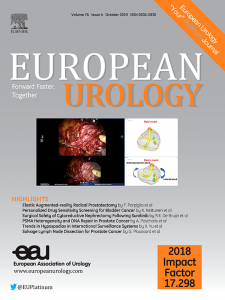Robot-assisted Single-docking Approach for Level III Inferior Vena Cava Tumor Thrombectomy: Surgical Technique and Outcomes
IF 25.3
1区 医学
Q1 UROLOGY & NEPHROLOGY
引用次数: 0
Abstract
Background and objective
Robot-assisted tumor thrombectomy (RATT) for level III inferior vena cava (IVC) tumor thrombus is an emerging but complex approach with limited reports. Variability in docking strategies, renal artery management, surgical exposure, and vascular control complicates adoption. We evaluated the safety, feasibility, and outcomes of RATT for level III IVC using a single-docking technique.Methods
This retrospective study included 15 patients who underwent RATT for level III IVC tumor thrombus at a tertiary center between 2019 and 2023. A novel strategy, including early division of the renal artery, IVC control, and tumor thrombectomy, was completed robotically without redocking. Distal repositioning of the IVC clamp was carried out when indicated. Median follow-up was 24 mo. Exclusion criteria were unresectable metastasis and severe comorbidities.Key findings and limitations
All surgeries were successfully completed using a single-docking technique. The median operative time was 225 min (range 140–375), and median blood loss was 400 ml (range: 200–2000). Twelve patients (80%) required intraoperative transfusions. The median IVC occlusion time was 14 min (range 8–25). Segmental IVC resection was performed in seven patients, with angioplasty reconstruction in two cases. Complications occurred in 73.3% (11/15), including three Clavien-Dindo grade IIIb events. At median follow-up of 24 mo, five patients had died and one had developed liver metastasis. Limitations include the small cohort size and the single-surgeon experience.Conclusions and clinical implications
Single-docking RATT for level III IVC tumor thrombus is a feasible and reproducible technique. Standardization of key surgical steps enhances procedural efficiency and addresses challenges in vascular control. This technique offers a viable alternative to multistage procedures in selected cases. Further validation with extended follow-up in multicenter studies is required.机器人辅助下腔静脉肿瘤III级血栓切除术的单对接入路:手术技术和结果
背景与目的机器人辅助肿瘤取栓术(RATT)治疗III级下腔静脉(IVC)肿瘤血栓是一种新兴但复杂的方法,报道有限。对接策略、肾动脉管理、手术暴露和血管控制的可变性使采用复杂化。我们使用单对接技术评估了RATT治疗III级IVC的安全性、可行性和结果。方法本回顾性研究纳入了2019年至2023年在三级中心接受III级IVC肿瘤血栓RATT治疗的15例患者。一种新的策略,包括肾动脉的早期分裂,IVC控制和肿瘤血栓切除,无需再对接机器人完成。当有指示时,进行IVC钳的远端重新定位。中位随访时间为24个月。排除标准为不可切除的转移和严重的合并症。主要发现和局限性所有手术均采用单对接技术成功完成。中位手术时间225 min(范围140-375),中位失血量400 ml(范围200-2000)。12例(80%)患者需要术中输血。中位下腔静脉闭塞时间为14 min(范围8-25)。7例患者行段性下腔静脉切除术,2例行血管成形术重建。并发症发生率为73.3%(11/15),包括3例Clavien-Dindo IIIb级事件。在中位随访24个月时,5例患者死亡,1例发生肝转移。局限性包括队列规模小和单一外科医生的经验。结论及临床意义单对接RATT治疗III级下腔静脉肿瘤血栓是一种可行且可重复的技术。关键手术步骤的标准化提高了手术效率,解决了血管控制方面的挑战。该技术在特定情况下为多阶段手术提供了可行的替代方案。需要在多中心研究中进行进一步的验证。
本文章由计算机程序翻译,如有差异,请以英文原文为准。
求助全文
约1分钟内获得全文
求助全文
来源期刊

European urology
医学-泌尿学与肾脏学
CiteScore
43.00
自引率
2.60%
发文量
1753
审稿时长
23 days
期刊介绍:
European Urology is a peer-reviewed journal that publishes original articles and reviews on a broad spectrum of urological issues. Covering topics such as oncology, impotence, infertility, pediatrics, lithiasis and endourology, the journal also highlights recent advances in techniques, instrumentation, surgery, and pediatric urology. This comprehensive approach provides readers with an in-depth guide to international developments in urology.
 求助内容:
求助内容: 应助结果提醒方式:
应助结果提醒方式:


